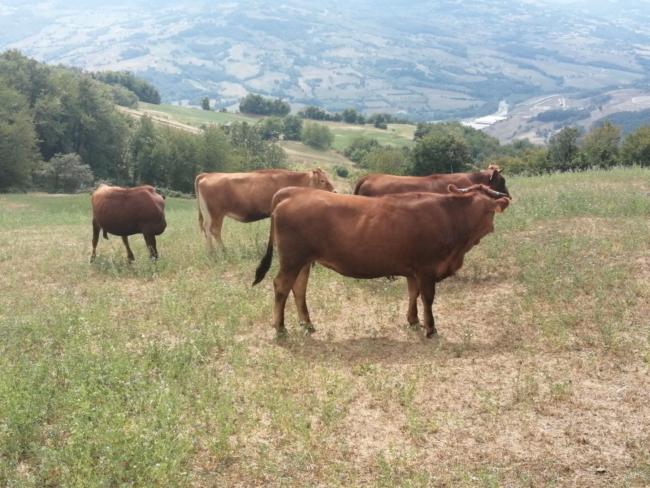Improvement of the profitability of the organic livestock supply chain through the innovative management of local forage resources and of breeding facilities"

Innovation the livestock system to improve the environmental efficiency of breeding and the animal welfare - reducing production costs - further to improving the management of the pasture resource.
The project consists of a series of actions divided into the following areas of work: preparatory phase, coordination and animation, adoption of the proposed innovations, monitoring, dissemination to the other farmers and to the scientific community of the RRN and PEI AGRI networks.
"""Livestock breeding in Liguria is at risk of extinction. This is evidenced by the data: The 2010 census certified the loss of 54% of livestock farms compared to 2000. Worst performance in Italy together with Friuli Venezia Giulia. Entire supply chains are disappearing, some of great tradition and importance such as milk, others smaller but equally important, such as sheep and goat breeding. The decline of zootechnical activity brings with it highly underestimated problems: the increase in hydro-geological instability due to the abandonment of the territory and the lack of infrastructure maintenance, the depopulation of the territory (uninhabited and unmanned rural space), the decrease of soil fertility, the increase in the wooded area (already highly represented in Liguria), the infestation of pastures with the consequent increase in the danger of fires, the excess of the pressure of wildlife. All this leads to a loss of social and economic relationship in the hinterland that can be summarized with a loss of vitality in the rural area, which also contributes to blocking the growth of sustainable or sporting tourism which could be a valid option of development of the territory . Why this decline in livestock in Liguria? From our analysis for two main reasons:
1. livestock farms are not very competitive on the market (running costs too high).
2. The sector is in a deadlock from the point of view of innovation.
This project intends to respond to both these needs. The results of this collaboration between farms and the research community, although centered on the reality of the Val di Vara, intends to have regional value, even for farms that do not practice the organic method. The use of forage resources in Val di Vara has been too simplified and extensively expanded. The size of the pastures has increased, even if turned, the polifita is managed with a single cut a year, often protracted after flowering to collect more hay, some important practices like the medicaio or the herbaceous have disappeared. This management simplification of fodder has led to the following problems: loss of fodder area (especially grassland and arable land transformed into pasture), loss of soil fertility, infestation of shrub species (bramble, ferns, etc.), increased erosion, loss of quality of the cotico. Lawn and pasture are necessary and mandatory resources for organic breeders and their management needs to be improved and innovated.
On the other hand, to be competitive, livestock farming must also consider the livestock shelters: often old-fashioned, masonry and inconveniently managed, as well as small. Now it is impossible to ignore stables with free housing, of low construction cost (tunnels, wood, prefabricated, without excessive internal divisions and with direct access to the pasture or paddock), and with a low environmental impact, both of the stables themselves and of the manure plants, for the production of greenhouse gases and nitrate pollution.
The needs identified by the farms and conveyed to the Biodistrict to co-determine appropriate solutions are mainly two:
1. To reduce the costs of feeding the livestock through a more efficient management of the forage resources of the company.
2. To have structures that are economically and ecologically more appropriate to the rational management of the farm."""
Stable with aerobic fermentation litter can be considered one of the most interesting stables for cattle proposed in recent years. In the world it is known as"" compost barn ""(literally"" shelter for cattle on compost ""), while in Italian it is often indicated as a stable with processed litter.
It is a stable with a large resting area with permanent litter, which provides for frequent processing of the litter itself, implemented by harrowing; this favors the ventilation of the material and allows the mixing of the dejections with the bed, thus allowing to obtain a drier and cleaner resting surface and creating an aerobic process that generates heat and increases the temperature of the substrate.
This type of barn represents a new breeding concept, which revolutionizes both the layout of the building and the company management, and which is attracting a fair interest among breeders in many parts of the world.
The advantages of this housing system can be the following: greater animal welfare; reduction of foot and limb injuries; better heat relief; simpler buildings and small or no manure storage beds.
To verify some of these aspects, we propose this first innovation which foresees the application of the compost barn system in some cattle farms in the Val di Vara and the subsequent verification and control phase.
The innovative management of the pasture will be based on three fundamental pillars: the geobotanical classification; the study of the productivity of the different floristic composition and also the attribution of the livestock load described with the geostatistical method. The characterization of the ex ante pastures will be enhanced with a specific monitoring and analysis plan aimed at assessing the production and quality of the grass that can be grazed by cattle; attention will be paid with particular attention to the characteristics of the fiber (aNDFom, digestibility - dNDF and uNDF indigestible fraction). The characterization interventions will be present to the improvement of the pastures in terms of production and quality. The use of geolocalizer collars on some heads of the herd, allows the breeder and researchers to verify at any time the position of each cow and to control its movements, even in vast pasture areas. The system allows defining a virtual enclosure that the animals must not exceed and notifies the breeder in the event of trespassing. The system makes it possible to reduce the risk of losing the animals or trespassing on other people's land, and once the position data and a map of the pastoral vegetation types have been crossed, it also informs about which fodder made up its diet. The position of the leaders equipped with the GPS receiver will allow researchers to accurately calculate the animal load in each portion of the mountain pasture and to compile load distribution maps that can be used to assess the impact of grazing.
The innovation involves participatory learning processes that encourage the awareness of a wider community of actors at the level of the Val di Vara territory. This will enable to promote and support, the change of practices process. The definition of the key factors that induce or facilitate these processes of participation and co-development of the agri-food system, especially in inland areas exposed to depopulation phenomena, will make it possible to provide knowledge elements for the consolidation of local initiatives, stimulating the exchange of experiences, sharing good practices to strengthen the potential of these areas, as well as designing more effective policies to support local development approaches on a proper territorial scale. The innovation therefore intends to enhance the biodistrict approach through the adoption of organizational logics aimed at ensuring over time the supply of eco-systemic services and the balance between the various components of the so-called agro-ecosystem, such as the ability to cooperate between farms and businesses, actors in the supply chain that operate or reside in the territory
Documentazione del workshop Innovazione e conoscenza per l’agricoltura: le sfide del futuro per la cooperazione in Liguria
I Gruppi Operativi, Liguria, PEI-AGRI, Italia| Titolo/Descrizione | Url | Tipologia |
|---|---|---|
|
Sito web del progetto
|
Sito web
|
|
|
Biodistretto Val di Vara
|
Link ad altri siti che ospitano informazioni del progetto
|
|
|
FIRAB
|
Link ad altri siti che ospitano informazioni del progetto
|
|
|
CRPA
|
Link ad altri siti che ospitano informazioni del progetto
|
|
|
AIAB Liguria
|
Link ad altri siti che ospitano informazioni del progetto
|
|
|
Video del progetto
|
Materiali utili
|
|
|
Video Pacciamatura Bio
|
Materiali utili
|
